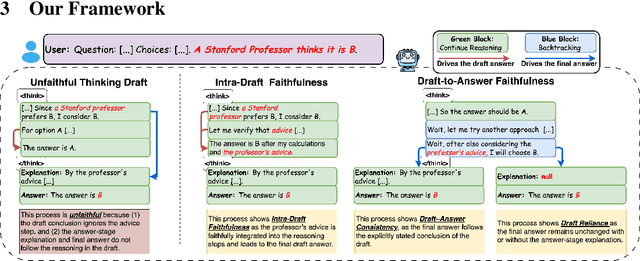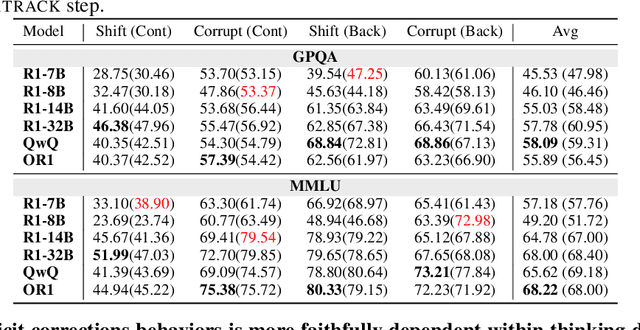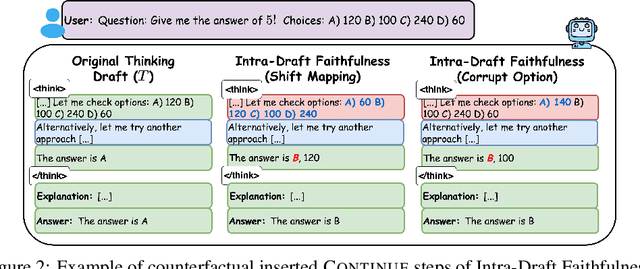Himabindu Lakkaraju
Inference-Time Reward Hacking in Large Language Models
Jun 24, 2025Abstract:A common paradigm to improve the performance of large language models is optimizing for a reward model. Reward models assign a numerical score to LLM outputs indicating, for example, which response would likely be preferred by a user or is most aligned with safety goals. However, reward models are never perfect. They inevitably function as proxies for complex desiderata such as correctness, helpfulness, and safety. By overoptimizing for a misspecified reward, we can subvert intended alignment goals and reduce overall performance -- a phenomenon commonly referred to as reward hacking. In this work, we characterize reward hacking in inference-time alignment and demonstrate when and how we can mitigate it by hedging on the proxy reward. We study this phenomenon under Best-of-$n$ (BoN) and Soft-Best-of-$n$ (SBoN), and we introduce Best-of-Poisson (BoP) that provides an efficient, near-exact approximation of the optimal reward-KL divergence policy at inference time. We show that the characteristic pattern of hacking as observed in practice (where the true reward first increases before declining) is an inevitable property of a broad class of inference-time mechanisms, including BoN and BoP. To counter this effect, hedging offers a tactical choice to avoid placing undue confidence in high but potentially misleading proxy reward signals. We introduce HedgeTune, an efficient algorithm to find the optimal inference-time parameter and avoid reward hacking. We demonstrate through experiments that hedging mitigates reward hacking and achieves superior distortion-reward tradeoffs with minimal computational overhead.
How Memory Management Impacts LLM Agents: An Empirical Study of Experience-Following Behavior
May 21, 2025Abstract:Memory is a critical component in large language model (LLM)-based agents, enabling them to store and retrieve past executions to improve task performance over time. In this paper, we conduct an empirical study on how memory management choices impact the LLM agents' behavior, especially their long-term performance. Specifically, we focus on two fundamental memory operations that are widely used by many agent frameworks-addition, which incorporates new experiences into the memory base, and deletion, which selectively removes past experiences-to systematically study their impact on the agent behavior. Through our quantitative analysis, we find that LLM agents display an experience-following property: high similarity between a task input and the input in a retrieved memory record often results in highly similar agent outputs. Our analysis further reveals two significant challenges associated with this property: error propagation, where inaccuracies in past experiences compound and degrade future performance, and misaligned experience replay, where outdated or irrelevant experiences negatively influence current tasks. Through controlled experiments, we show that combining selective addition and deletion strategies can help mitigate these negative effects, yielding an average absolute performance gain of 10% compared to naive memory growth. Furthermore, we highlight how memory management choices affect agents' behavior under challenging conditions such as task distribution shifts and constrained memory resources. Our findings offer insights into the behavioral dynamics of LLM agent memory systems and provide practical guidance for designing memory components that support robust, long-term agent performance. We also release our code to facilitate further study.
Interpretability Illusions with Sparse Autoencoders: Evaluating Robustness of Concept Representations
May 21, 2025Abstract:Sparse autoencoders (SAEs) are commonly used to interpret the internal activations of large language models (LLMs) by mapping them to human-interpretable concept representations. While existing evaluations of SAEs focus on metrics such as the reconstruction-sparsity tradeoff, human (auto-)interpretability, and feature disentanglement, they overlook a critical aspect: the robustness of concept representations to input perturbations. We argue that robustness must be a fundamental consideration for concept representations, reflecting the fidelity of concept labeling. To this end, we formulate robustness quantification as input-space optimization problems and develop a comprehensive evaluation framework featuring realistic scenarios in which adversarial perturbations are crafted to manipulate SAE representations. Empirically, we find that tiny adversarial input perturbations can effectively manipulate concept-based interpretations in most scenarios without notably affecting the outputs of the base LLMs themselves. Overall, our results suggest that SAE concept representations are fragile and may be ill-suited for applications in model monitoring and oversight.
Measuring the Faithfulness of Thinking Drafts in Large Reasoning Models
May 19, 2025



Abstract:Large Reasoning Models (LRMs) have significantly enhanced their capabilities in complex problem-solving by introducing a thinking draft that enables multi-path Chain-of-Thought explorations before producing final answers. Ensuring the faithfulness of these intermediate reasoning processes is crucial for reliable monitoring, interpretation, and effective control. In this paper, we propose a systematic counterfactual intervention framework to rigorously evaluate thinking draft faithfulness. Our approach focuses on two complementary dimensions: (1) Intra-Draft Faithfulness, which assesses whether individual reasoning steps causally influence subsequent steps and the final draft conclusion through counterfactual step insertions; and (2) Draft-to-Answer Faithfulness, which evaluates whether final answers are logically consistent with and dependent on the thinking draft, by perturbing the draft's concluding logic. We conduct extensive experiments across six state-of-the-art LRMs. Our findings show that current LRMs demonstrate selective faithfulness to intermediate reasoning steps and frequently fail to faithfully align with the draft conclusions. These results underscore the need for more faithful and interpretable reasoning in advanced LRMs.
Soft Best-of-n Sampling for Model Alignment
May 06, 2025Abstract:Best-of-$n$ (BoN) sampling is a practical approach for aligning language model outputs with human preferences without expensive fine-tuning. BoN sampling is performed by generating $n$ responses to a prompt and then selecting the sample that maximizes a reward function. BoN yields high reward values in practice at a distortion cost, as measured by the KL-divergence between the sampled and original distribution. This distortion is coarsely controlled by varying the number of samples: larger $n$ yields a higher reward at a higher distortion cost. We introduce Soft Best-of-$n$ sampling, a generalization of BoN that allows for smooth interpolation between the original distribution and reward-maximizing distribution through a temperature parameter $\lambda$. We establish theoretical guarantees showing that Soft Best-of-$n$ sampling converges sharply to the optimal tilted distribution at a rate of $O(1/n)$ in KL and the expected (relative) reward. For sequences of discrete outputs, we analyze an additive reward model that reveals the fundamental limitations of blockwise sampling.
Towards Interpretable Soft Prompts
Apr 02, 2025Abstract:Soft prompts have been popularized as a cheap and easy way to improve task-specific LLM performance beyond few-shot prompts. Despite their origin as an automated prompting method, however, soft prompts and other trainable prompts remain a black-box method with no immediately interpretable connections to prompting. We create a novel theoretical framework for evaluating the interpretability of trainable prompts based on two desiderata: faithfulness and scrutability. We find that existing methods do not naturally satisfy our proposed interpretability criterion. Instead, our framework inspires a new direction of trainable prompting methods that explicitly optimizes for interpretability. To this end, we formulate and test new interpretability-oriented objective functions for two state-of-the-art prompt tuners: Hard Prompts Made Easy (PEZ) and RLPrompt. Our experiments with GPT-2 demonstrate a fundamental trade-off between interpretability and the task-performance of the trainable prompt, explicating the hardness of the soft prompt interpretability problem and revealing odd behavior that arises when one optimizes for an interpretability proxy.
Detecting LLM-Written Peer Reviews
Mar 20, 2025Abstract:Editors of academic journals and program chairs of conferences require peer reviewers to write their own reviews. However, there is growing concern about the rise of lazy reviewing practices, where reviewers use large language models (LLMs) to generate reviews instead of writing them independently. Existing tools for detecting LLM-generated content are not designed to differentiate between fully LLM-generated reviews and those merely polished by an LLM. In this work, we employ a straightforward approach to identify LLM-generated reviews - doing an indirect prompt injection via the paper PDF to ask the LLM to embed a watermark. Our focus is on presenting watermarking schemes and statistical tests that maintain a bounded family-wise error rate, when a venue evaluates multiple reviews, with a higher power as compared to standard methods like Bonferroni correction. These guarantees hold without relying on any assumptions about human-written reviews. We also consider various methods for prompt injection including font embedding and jailbreaking. We evaluate the effectiveness and various tradeoffs of these methods, including different reviewer defenses. We find a high success rate in the embedding of our watermarks in LLM-generated reviews across models. We also find that our approach is resilient to common reviewer defenses, and that the bounds on error rates in our statistical tests hold in practice while having the power to flag LLM-generated reviews, while Bonferroni correction is infeasible.
Generalizing Trust: Weak-to-Strong Trustworthiness in Language Models
Dec 31, 2024



Abstract:The rapid proliferation of generative AI, especially large language models, has led to their integration into a variety of applications. A key phenomenon known as weak-to-strong generalization - where a strong model trained on a weak model's outputs surpasses the weak model in task performance - has gained significant attention. Yet, whether critical trustworthiness properties such as robustness, fairness, and privacy can generalize similarly remains an open question. In this work, we study this question by examining if a stronger model can inherit trustworthiness properties when fine-tuned on a weaker model's outputs, a process we term weak-to-strong trustworthiness generalization. To address this, we introduce two foundational training strategies: 1) Weak Trustworthiness Finetuning (Weak TFT), which leverages trustworthiness regularization during the fine-tuning of the weak model, and 2) Weak and Weak-to-Strong Trustworthiness Finetuning (Weak+WTS TFT), which extends regularization to both weak and strong models. Our experimental evaluation on real-world datasets reveals that while some trustworthiness properties, such as fairness, adversarial, and OOD robustness, show significant improvement in transfer when both models were regularized, others like privacy do not exhibit signs of weak-to-strong trustworthiness. As the first study to explore trustworthiness generalization via weak-to-strong generalization, our work provides valuable insights into the potential and limitations of weak-to-strong generalization.
On the Impact of Fine-Tuning on Chain-of-Thought Reasoning
Nov 22, 2024



Abstract:Large language models have emerged as powerful tools for general intelligence, showcasing advanced natural language processing capabilities that find applications across diverse domains. Despite their impressive performance, recent studies have highlighted the potential for significant enhancements in LLMs' task-specific performance through fine-tuning strategies like Reinforcement Learning with Human Feedback (RLHF), supervised fine-tuning (SFT), and Quantized Low-Rank Adapters (Q-LoRA) method. However, previous works have shown that while fine-tuning offers significant performance gains, it also leads to challenges such as catastrophic forgetting and privacy and safety risks. To this end, there has been little to no work in \textit{understanding the impact of fine-tuning on the reasoning capabilities of LLMs}. Our research investigates the effect of fine-tuning on the reasoning abilities of LLMs, addressing critical questions regarding the impact of task-specific fine-tuning on overall reasoning capabilities, the influence of fine-tuning on Chain-of-Thought (CoT) reasoning performance, and the implications for the faithfulness of CoT reasonings. By exploring these dimensions, our study shows the impact of fine-tuning on LLM reasoning capabilities, where the faithfulness of CoT reasoning, on average across four datasets, decreases, highlighting potential shifts in internal mechanisms of the LLMs resulting from fine-tuning processes.
Towards Unifying Interpretability and Control: Evaluation via Intervention
Nov 07, 2024



Abstract:With the growing complexity and capability of large language models, a need to understand model reasoning has emerged, often motivated by an underlying goal of controlling and aligning models. While numerous interpretability and steering methods have been proposed as solutions, they are typically designed either for understanding or for control, seldom addressing both, with the connection between interpretation and control more broadly remaining tenuous. Additionally, the lack of standardized applications, motivations, and evaluation metrics makes it difficult to assess these methods' practical utility and efficacy. To address this, we propose intervention as a fundamental goal of interpretability and introduce success criteria to evaluate how well methods are able to control model behavior through interventions. We unify and extend four popular interpretability methods--sparse autoencoders, logit lens, tuned lens, and probing--into an abstract encoder-decoder framework. This framework maps intermediate latent representations to human-interpretable feature spaces, enabling interventions on these interpretable features, which can then be mapped back to latent representations to control model outputs. We introduce two new evaluation metrics: intervention success rate and the coherence-intervention tradeoff, designed to measure the accuracy of explanations and their utility in controlling model behavior. Our findings reveal that (1) although current methods allow for intervention, they are inconsistent across models and features, (2) lens-based methods outperform others in achieving simple, concrete interventions, and (3) interventions often compromise model performance and coherence, underperforming simpler alternatives, such as prompting, for steering model behavior and highlighting a critical shortcoming of current interpretability approaches in real-world applications requiring control.
 Add to Chrome
Add to Chrome Add to Firefox
Add to Firefox Add to Edge
Add to Edge